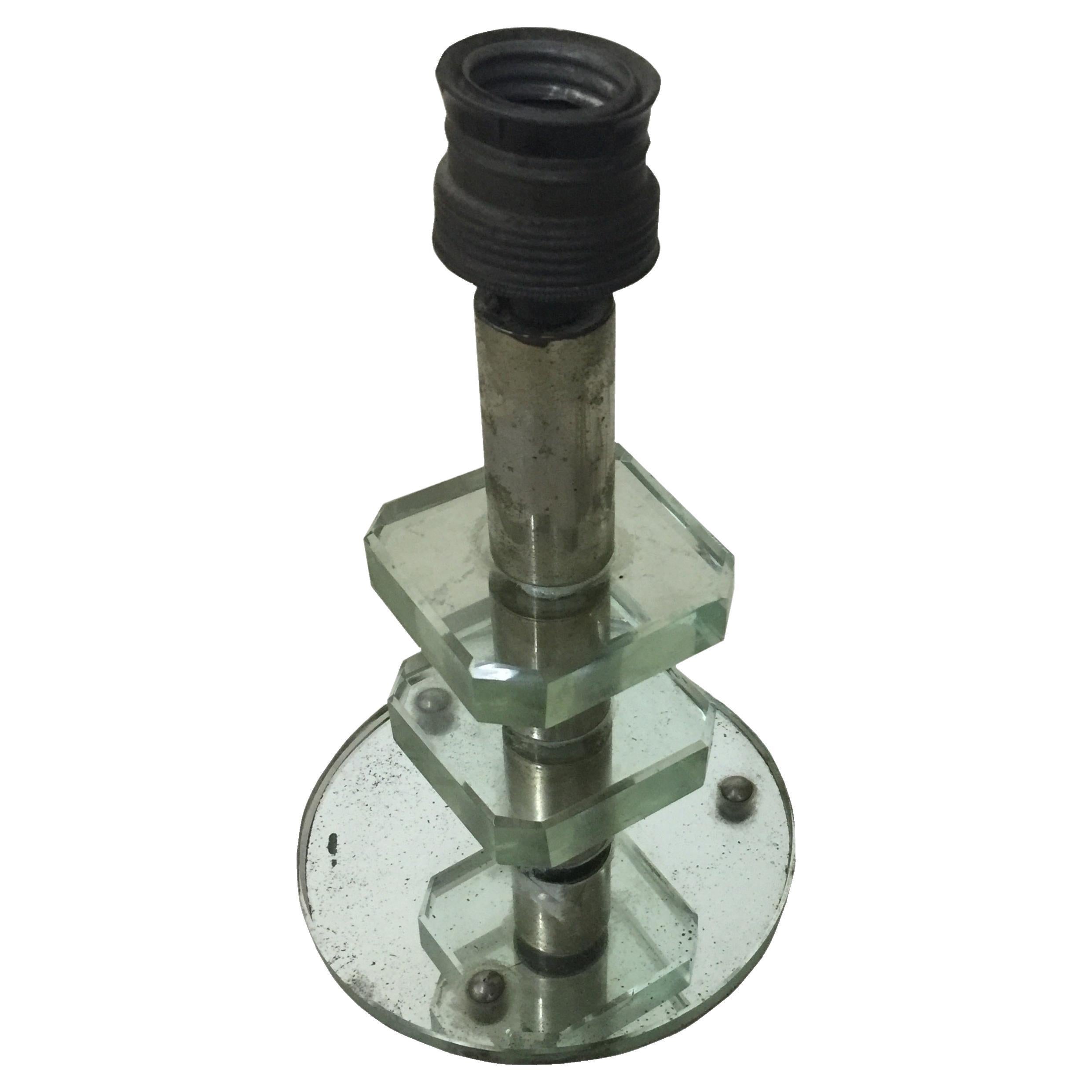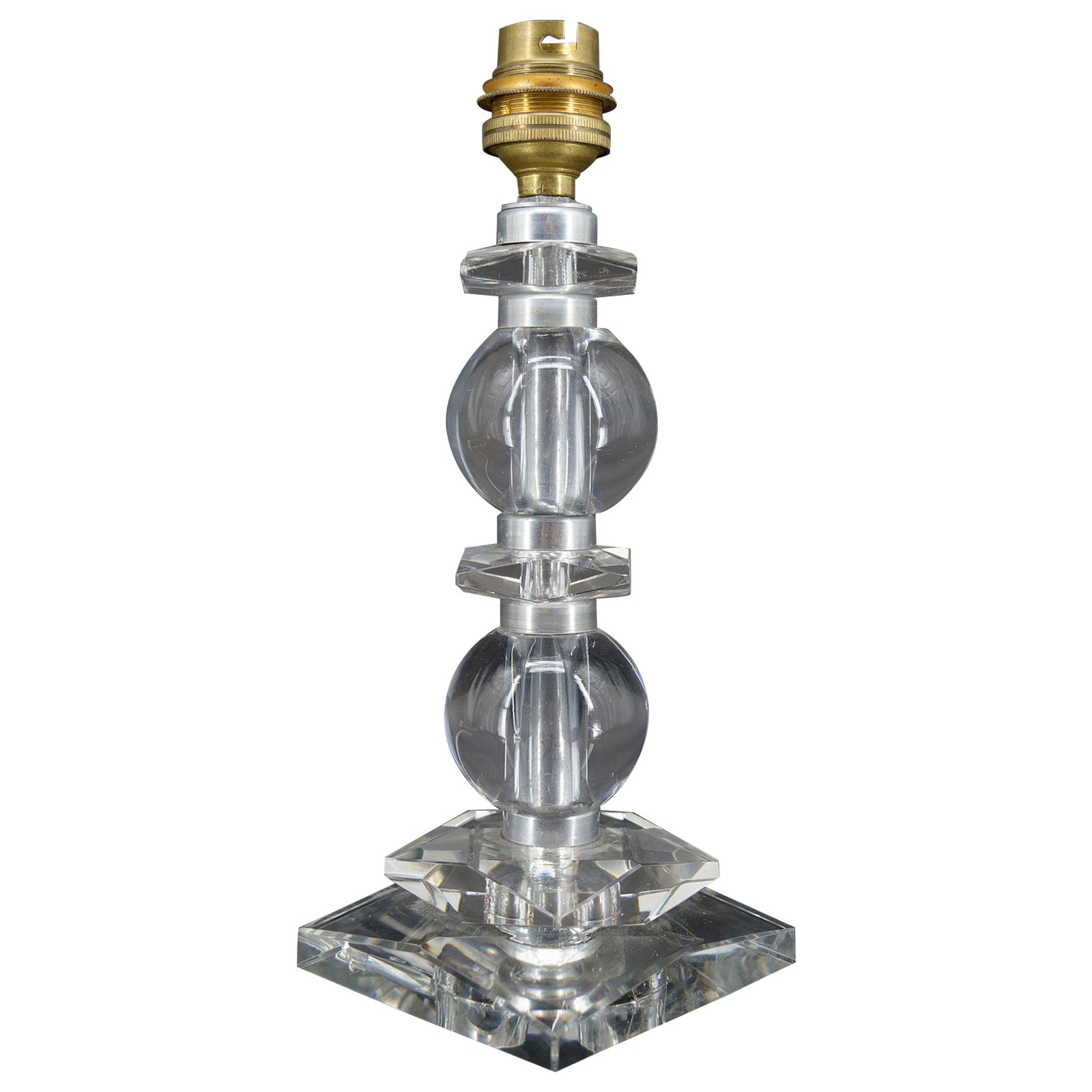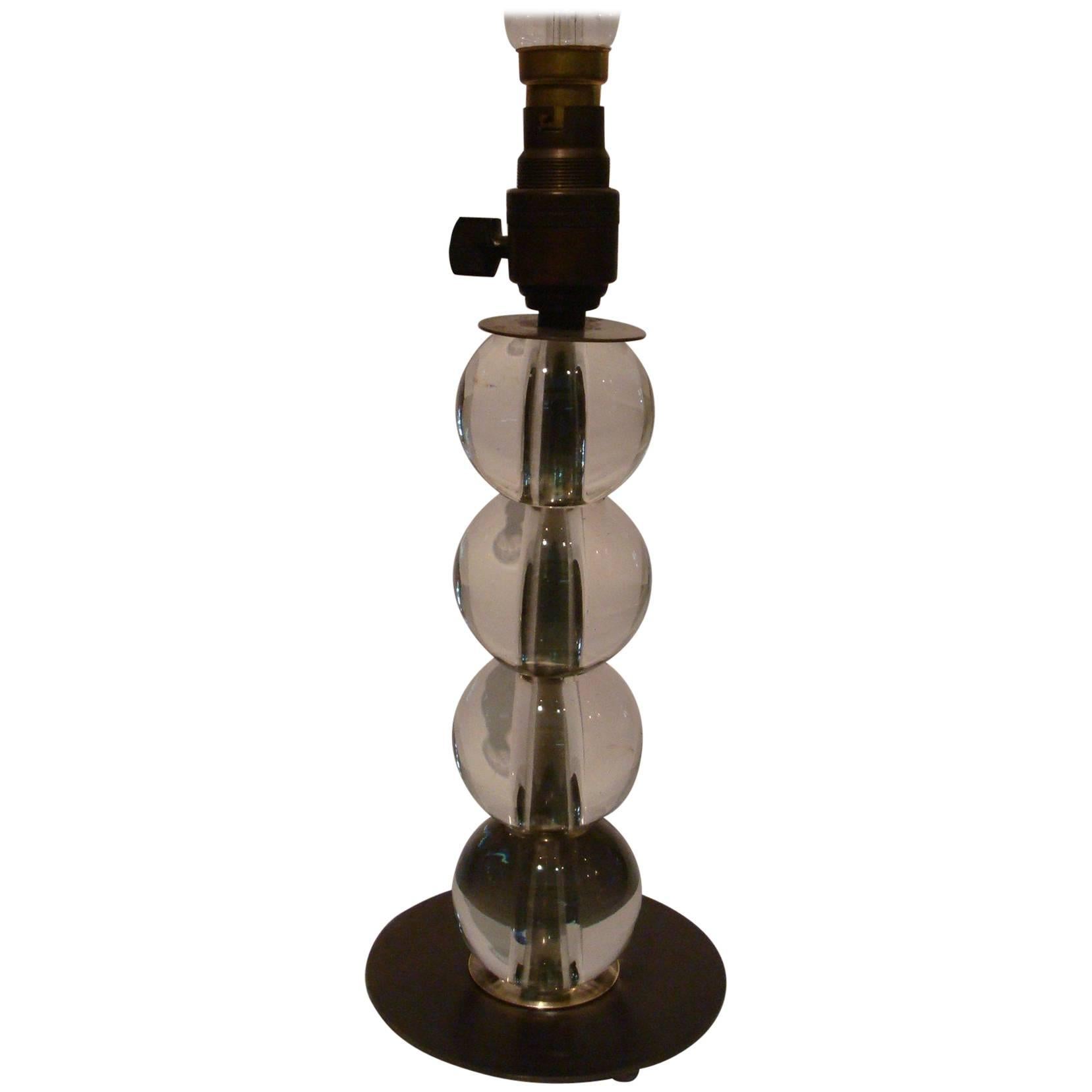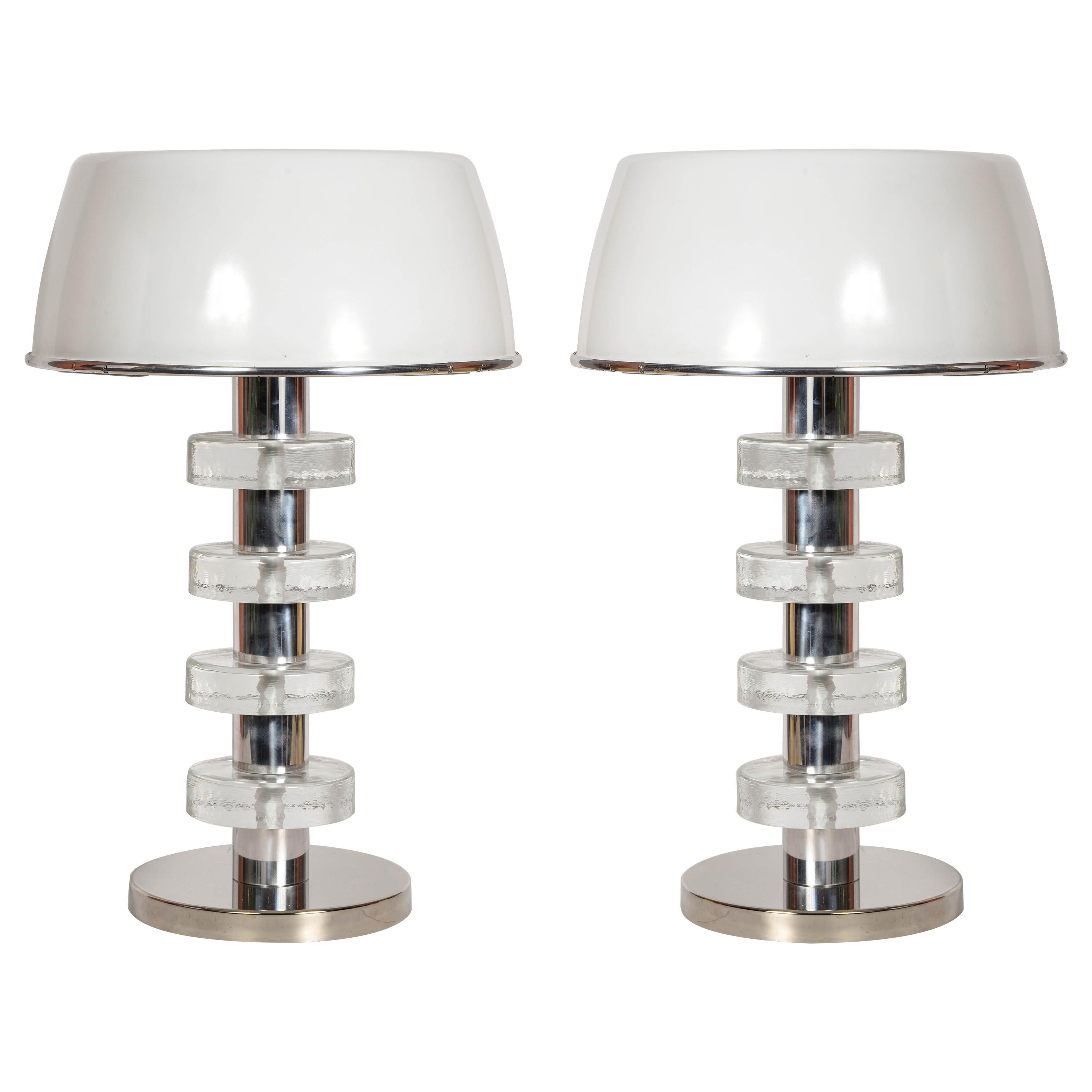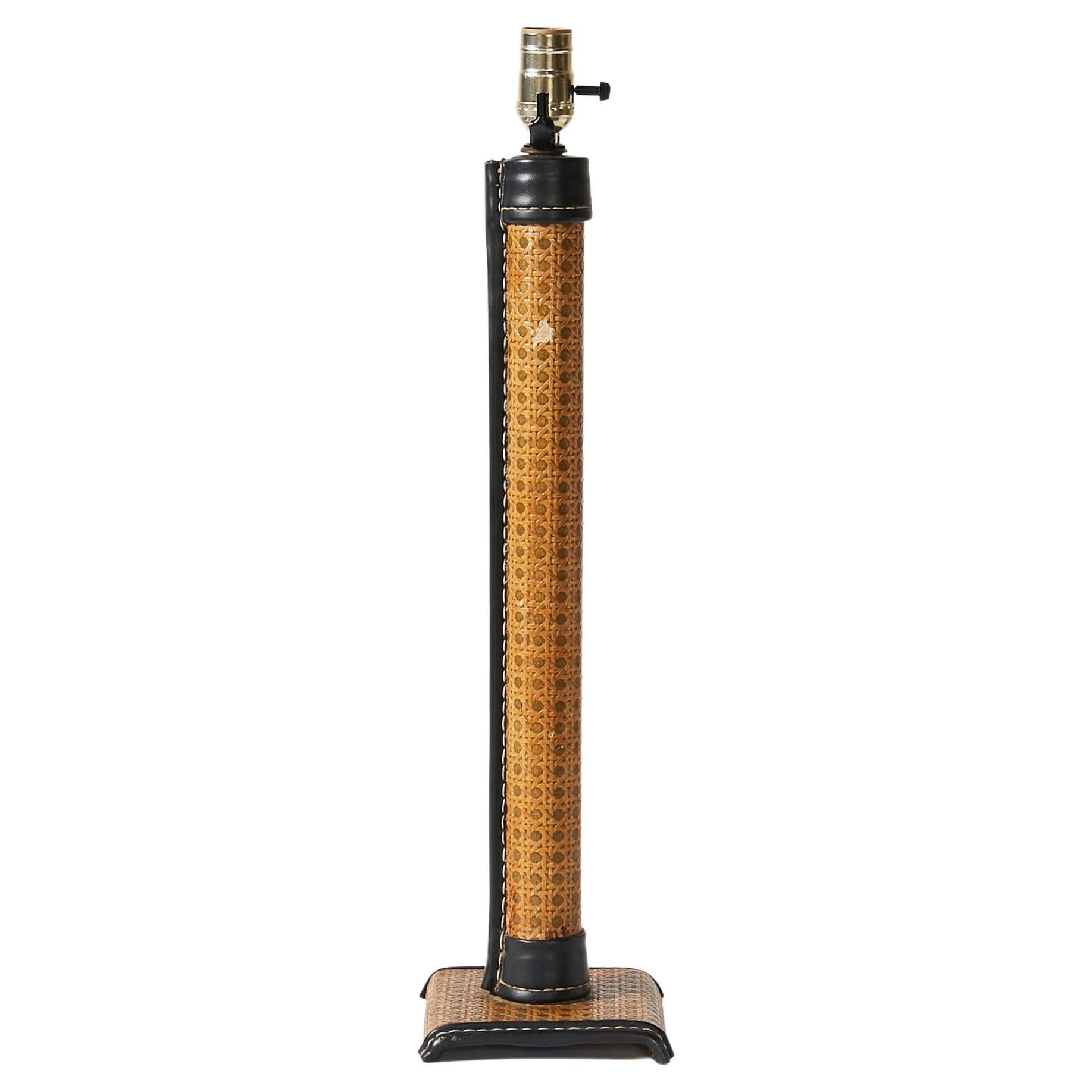Items Similar to Art Deco Lamp, 1920, Attributed to Adnet Jacques , France , crystal and bronze
Video Loading
Want more images or videos?
Request additional images or videos from the seller
1 of 11
Art Deco Lamp, 1920, Attributed to Adnet Jacques , France , crystal and bronze
About the Item
Table lamp Art deco
Materia: Bronze and crystal
Style: Art Deco
Country: France
To take care of your property and the lives of our customers, the new wiring has been done.
We have specialized in the sale of Art Deco and Art Nouveau and Vintage styles since 1982. If you have any questions we are at your disposal.
Pushing the button that reads 'View All From Seller'. And you can see more objects to the style for sale.
Jacques Adnet was a furniture designer known for his mirrors, lamps, chairs, and tables. Each piece was designed with the clean lines and simple forms of an unadorned Art Deco style, and subsequently rendered in glass, metal, leather, or wood. Born on April 20, 1900 in Chatillon-Coligny, France, he studied architecture under Charles Louis Genuys at the École des Arts Décoratifs in 1916. From 1923 until 1928, he worked with his twin brother Jean Adnet, under the collaborative moniker Jean & Jacques Adnet. Together they would exhibit at the Exposition Internationale des Arts Décoratifs et Industriels Modernes in 1925, where the term Art Deco is said to have first been coined. Jacques Adnet went on to direct La Compagnie des Arts Français until its closure in 1959, collaborating with Charlotte Perriand, Francois Jourdain, and others who shared his innovative approach to design. The designer died on October 29, 1984 in Paris, France.
Why are there so many antiques in Argentina?
In the 1880 – 1940 there was a grate wave of immigration encouraged by the periods of war that were taking place.
1st World War took place between 1914 and 1918
2nd World War took place between 1939 and 1945
The immigrants options were New York or Buenos Aires. Tickets were cheap and in Buenos Aires they were welcomed with open arms, as it was a country where everything was still to be done.
Argentina was the country of new opportunities, labour was needed and religious freedom was assured, in many cases the of the family travel first until they were settled and then the rest of the family members join them.
In the immigrant museum “Ellis Island Immigrant Building” in New York you can se the promotional posters of the boats that would take them to a new life.
Between the years 1895 and 1896, Argentina had the highest DGP (gross domestic product) per capita in the world according to the Maddison Historical Statistics index, this situation arose due to the large amount of food being exported to European countries, which were at war.
The Argentinean ships left the port of Buenos Aires with food, but they returned with furniture, clothes and construction elements, (it´s common to see this the old buildings of the historic neighbourhood of San Telmo, the beams with the inscription “Made in England)”, as well as many markets that were built in Buenos Aires, such us the San Telmo Market, whose structure was brought by ship and afterwards assembled in 900 Defensa Street.
With the great influence of European immigrants living in the country, the children of the upper classes travelled to study in France, resulting in the inauguration of “La Maison Argentinienne”, on 27th of June 1928, in the international city of Paris, which hosted many Argentinians that were studying in Frace.
It´s the fourth house to be built after France, Canada and Belgium, being the first Spanish-speaking one. Still in place today (17 Bd Jourdan, 75014, Paris, France). Many of the children of these wealthy families who attended international art exhibitions, museums and art courses abroad, took a keen interest in the European style. This is why Buenos Aires was at the time referred as “The Paris of South America”.
Between the years 1890 and 1920 more than a hundred Palaces were built on Alvear Avenue the most exclusive avenue in Buenos Aires. Today some of these palaces have been transformed into museums, hotels and embassies.
In the year 1936, the Kavanagh building was inaugurated, it was the tallest reinforced concrete building in South America.
During 1994 the American Society of Civil Engineers distinguished it as an “international engineering milestone”, and it´s now considered a World Heritage of Modern Architecture.
At the time was common to hire foreign architects such as Le Corbusier, who visited Buenos Aires/Argentina in 1929 and in 1948 he drew up the blueprints for a house built in La Plata City (which was declared a World Heritage Site).
In 1947, the Hungarian architect Marcelo Breuer designed “Parador Ariston” in the seaside city of Mar del Plata. After an Argentinean student at Harvard University convinced him to come to Argentina. He worked on an urban development project in the Casa Amarilla, area of La Boca.
The Ukrainian architect, Vladimiro Acosta, arrives in Argentina in 1928 and worked as an architect until que moved to Brazil.
Antonio Bonet, a Spanish architect who worked with Le Corbusier in Paris, arrives in Argentina in 1937, where he carried out several architectural works and in 1938 designs the well-known BFK chair.
Andres Kálnay, of Hungarian origin, made around 120 architectural masterpieces, among which the former Munich brewery stands out, he even made the furniture’s design.
The German architect, Walter Gropius, director of the Bauhaus, lived in Argentina, where he wrote articles for “Sur” magazine and founded in Buenos Aires, an architectural firm with Franz Möller, who was also an architect, where he built two houses.
At the same time several famous designers decided to immigrate to Argentina, among them we can find the well-known French designer, Jean-Michel Frank, who arrived in the country in 1940 and also worked for the Rockefeller family.
Special pieces were made, which were sold exclusively in the country, such as the well-known German company “WMF”, who sold their products by catalogue, which were chosen by the ladies of high society in the list of wedding gifts, as well as the pieces designed by Christofle.
The Swiss sculptor Alberto Giacometti, made special pieces for Argentinean mansions.
In 1904 the first Jansen branch outside Paris was established in Buenos Aires, as the Argentinean clientele demanded a large amount of furniture, from the end of the 19th century to the mid-20th century.
In 1970, the brand Rigolleau Argentina made pieces authorised by Lalique.
The brands Maple and Thompson also set up shop in the country.
The French plastic artist, Marcel Duchamp moved to Argentina in 1918-1919.
Glass signed Gallé, Charder, Leverre, Schneider, Muller and other French firms. They were bought in flower shops and were given to ladies with beautiful floral arrangements.
Some furniture manufacturers travelled to international fairs and bough the patterns to produce the furniture in Argentina, such as the furniture firm Englander and Bonta, who bought the patterns ins Italy.
It is worth mentioning that in Argentina we have the largest community of Italians outside of Italy, as it is estimated that 70 percent of the inhabitants have at least one Italian descendant, followed by Spanish immigrants.
The most Important furniture stores in Argentina:
Comte is founded in 1934 (under the direct management of Jean Michel Frank in 1940).
Nordiska (Swedish company established in 1934).
Churba in 1960, a company that brought foreign designers to present their furniture in the country:
Denmark: (Arne Jacobsen, Finn Juhl, Bender Madsen, Ejner Larsen, Poul Kjaerholm, Hans Wegner)
Sweden: (Hans Agne Jakobsson, Gustavsberg)
United States: (Herman Miller)
Finland: (Lisa Johansson, Folke Arstrom, Tapio Wirkkala, Alvar Aalto, Timo Sarpaneva)
Swedish Factory: (Orrefors)
Italy: (Littala, Vico Magistretti, Emma Gismondi, Gae Aulenti, Angelo Mangiarotti, Elio Martinelli, Gianna Celada, Angelo Mangiarotti, Mario Bellini, Carlo Scarpa)
Finland: (Olivia Toikka)
Plata Lappas (Lappas Silver): a goldsmith shop founded in 1887 in Argentina by Alcibiades Lappas of Greek origin.
In 2019, in Argentina took place “the Art Deco world congress”, in which we participated as hosts invited by Geo Darder, founder of the Copperbridge – Foundation, in which prominent people from all over the world attended to learn about Art Deco in Argentina.
Argentina currently has more than 100 Art Deco buildings and another 90 Art Nouveau buildings throughout the city of Buenos Aires.
Argentina is a country that has not been involved in many wars, which is why it has been a refuge for works of art and antiques from different periods of time, unlike European countries. That is way many collectors, museums and antique dealers from all over the world visit it, you should not miss the opportunity to visit this great country.
Laura Guevara Kjuder, architect.
- Attributed to:Jacques Adnet (Artist)
- Dimensions:Height: 9.85 in (25 cm)Width: 4.34 in (11 cm)Depth: 4.34 in (11 cm)
- Power Source:Plug-in
- Voltage:220-240v
- Lampshade:Not Included
- Style:Art Deco (Of the Period)
- Materials and Techniques:
- Place of Origin:
- Period:
- Date of Manufacture:1920
- Condition:Wear consistent with age and use. It has a detail at the base of the opaline.
- Seller Location:Ciudad Autónoma Buenos Aires, AR
- Reference Number:
About the Seller
5.0
Vetted Seller
These experienced sellers undergo a comprehensive evaluation by our team of in-house experts.
Established in 1982
1stDibs seller since 2022
21 sales on 1stDibs
Typical response time: <1 hour
- ShippingRetrieving quote...Ships From: Ciudad Autónoma Buenos Aires, Argentina
- Return PolicyThis item cannot be returned.
More From This SellerView All
- Art Deco Lamp, 1920, Attributed to Adnet Jacques, France, Crystal and MirrorBy Jacques AdnetLocated in Ciudad Autónoma Buenos Aires, CTable lamp Art deco Materia: Mirror and crystal Style: Art Deco Country: France To take care of your property and the lives of our customers, the new wiring has been done. If you wa...Category
Vintage 1920s French Art Deco Table Lamps
MaterialsCrystal
- Art Deco Lamp, 1920, Attributed to Adnet Jacques , France , crystal and woodBy Jacques AdnetLocated in Ciudad Autónoma Buenos Aires, CTable lamp Art deco Materia: wood and crystal Style: Art Deco Country: France To take care of your property and the lives of our customers, the new wiring has been done. If you want...Category
Vintage 1920s French Art Deco Table Lamps
MaterialsCrystal
- Art Deco Lamp, 1920, in chrome, France. Attributed to Jean PerzelBy Atelier Jean PerzelLocated in Ciudad Autónoma Buenos Aires, CTable Lamp Art deco Materia: chrome Style: Art Deco Country: France To take care of your property and the lives of our customers, the new wiring has been done. If you want to live i...Category
Vintage 1920s French Art Deco Table Lamps
MaterialsChrome
- Art Deco Lamp, 1920, Materials, Bronze and Opaline, FranceLocated in Ciudad Autónoma Buenos Aires, CTable lamp Art deco Materia: Bronze and opaline Style: Art Deco Country: France To take care of your property and the lives of our customers, the new wiring has been done. If you wa...Category
Vintage 1920s French Art Deco Table Lamps
MaterialsBronze
- Art Deco Lamp, 1920, Material, Bronze and Opaline, FranceLocated in Ciudad Autónoma Buenos Aires, CTable lamp Art deco Materia: Opaline and bronze Style: Art Deco Country: France To take care of your property and the lives of our customers, the new wiring has been done. If you w...Category
Vintage 1920s French Art Deco Table Lamps
MaterialsBronze
- English Art Deco Lamp, 1920, Material, Ceramic, Attributed to Susie CooperBy Susie CooperLocated in Ciudad Autónoma Buenos Aires, CTable lamp Art deco Attributed to Susie Cooper Materia: ceramic and bronze Style: Art Deco Country: England To take care of your property and the lives of our customers, the new wi...Category
Vintage 1920s English Art Deco Table Lamps
MaterialsBronze
You May Also Like
- Art Deco crystal lamp, Attributed to Jacques Adnet for Bacarrat, France, 1940'sBy Cristalleries De Baccarat, Jacques AdnetLocated in VÉZELAY, FRCrystal lamp. Art Deco, France, Circa 1940 Attributed to Jacques Adnet for Bacarrat. In good condition, electricity OK. Dimensions: height 23 cm width 10 cm depth 10 cmCategory
Vintage 1940s French Art Deco Table Lamps
MaterialsCrystal
- Jacques Adnet Art Deco Crystal Balls Table Lamp, France, 1930sBy Jacques AdnetLocated in Buenos Aires, OlivosJacques Adnet Art Deco crystal balls table lamp, France, 1930s. Stamped made in France.Category
Vintage 1930s French Art Deco Table Lamps
MaterialsCrystal, Bronze
- Pair of Lamps Attributed to Jacques AdnetBy Jacques AdnetLocated in Bois-Colombes, FRPair of lamps attributed to Jacques Adnet Glass and chromed metal.Category
Vintage 1950s European Table Lamps
MaterialsGlass
- French Table Lamp in Cane and Leather Attribute to Jacque AdnetBy Jacques AdnetLocated in Philadelphia, PAFrench table lamp attributed to Jacque Adnet. Base and stem covered in cane with details in blue leather with contrast stitching. This item has been rewired with new hardware and br...Category
Mid-20th Century French Mid-Century Modern Table Lamps
MaterialsLeather, Cane
- Jacques Adnet French Art Deco Machine Age Art Deco LampBy Jacques AdnetLocated in Oakland, CAJacques Adnet French Art Deco Machine Age Art Deco lamp. Original condition with round crystal spheres making up the stem utilizing machine age plated brass shade and base. A unique ...Category
Vintage 1930s French Art Deco Table Lamps
MaterialsNickel
- Jacques Adnet and Black Baccarat Crystal Ball Art Deco Table LampBy Jacques AdnetLocated in Oakland, CARare Jacques Adnet lamp made with Baccarat black crystal and a nickel base. The ball can be moved to different positions. This lamp is from the 1940s and is documented in the Adnet book...Category
Vintage 1930s French Art Deco Table Lamps
MaterialsCrystal, Metal
Recently Viewed
View AllMore Ways To Browse
Adnet Jacques
French Leather 1920
Jacque High
Bronze Leather French Table
Leather Art Deco Table
Wood Entry Table 1920
Art Deco Bronze Glass Lamp
Glass And Bronze Art Deco Lamp
Metal French Art Deco Lamp
Deco France Table Lamp Bronze
Glass And Bronze Art Nouveau Lamp
Street Lamp Art
French Modern Bronze Table Lamps
Bronze Lamp Stands
French Street Lamp
Street Lamp France
Art Deco Lamp Set
1920 Wood Lamp
